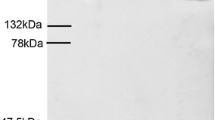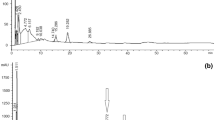Abstract
The yolk protein precursor vitellogenin (Vtg) in plasma has proved to be a simple and sensitive biomarker for assessing exposure of fish to environmental estrogens. Within international bodies such as the Organization for Economic Cooperation and Development (OECD) work is ongoing to develop screening and testing programmes for endocrine disrupting effects of new chemicals, and in the focus of this development are the fish test species common carp (Cyprinus carpio), fathead minnow (Pimephales promelas), zebrafish (Danio rerio) and Japanese medaka (Oryzias latipes). In this study we have developed quantitative enzyme linked immunosorbent assays (ELISAs) for Vtg in common carp/fathead minnow, zebrafish and Japanese medaka. The assays were developed using a combination of monoclonal and polyclonal fish Vtg antibodies in a sandwich format, using stabilized Vtg from the test species as a standard. The carp Vtg ELISA has a working range of 1–63 ng/mL, a minimal detection limit of 0.6 ng/mL, and may also be used for quantification of Vtg in fathead minnow. In fathead minnow whole-body homogenate samples, the practical detection limit is 400 ng/mL due to the matrix effect. The zebrafish Vtg ELISA has a working range of 0.5–63 ng/mL, a minimal detection limit of 0.4 ng/mL, and a practical detection limit of 200 ng/mL in whole-body homogenate samples. The medaka Vtg ELISA has a working range of 0.25–16 ng/mL, a minimal detection limit of 0.1 ng/mL, and a practical detection limit of 125 ng/mL in whole-body homogenate samples. The intra- and inter-assay variations were below 20% for all assays. The assays were evaluated with sets of representative samples spanning the wide dynamic range of Vtg-levels found in fish exposed to environmental estrogens, and all three assays are currently undergoing international inter-laboratory validation.









Similar content being viewed by others
References
Mommsen TP, Walsh PJ (1988) Vitellogenesis and oocyte assembly. In: Hoar WS, Randall VJ (eds) Fish Physiology, XIA. Academic Press, New York, pp 347–406
Arukwe A, Goksøyr A (2003) Comp Hepatol 2:4
Sumpter JP, Jobling S (1995) Environ Health Perspect 103 (Suppl 7): 173–178
Kime DE (1995) Rev Fish Biol Fisheries 5:52–96
Arukwe A, Goksøyr A (1998) Sarsia 83:225–241
Crowther JR (2001) The ELISA Guidebook. In: Methods Mol Biol. 149. Humana Press, Totowa, NJ
Tyler CR, van Aerle R, Nilsen MV, Blackwell R, Maddix S, Nilsen BM, Berg K, Hutchinson TH, Goksøyr A (2002) Environ Toxicol Chem 21:47–54
Norberg B (1995) Fish Physiol Biochem 14:1-13
Brion F, Rogerieux F, Noury P, Migeon B, Flammarion P, Thybaud E, Porcher JM (2000) J Chromatogr B 737:3-12
Brion F, Nilsen BM, Eidem JK, Goksøyr A, Porcher JM (2002) Environ Toxicol Chem 28:1699–1708
Laemmli UK (1970) Nature 227:680–685
Folmar LC, Denslow ND, Rao V, Chow M, Crain DA, Enblom J, Marcino J, Guillette Jr. LJ (1996) Environ Health Perspect 104:1096–1101
Harlow E, Lane D (1988) (eds) Antibodies—a laboratory manual. Cold Spring Harbor Laboratory Press, New York
Kordes C, Rieber EP, Gutzeit HO (2002) Aquat Toxicol 58:151–164
Tyler CR, Sumpter JP (1990) Fish Physiol Biochem 8:129–140
Towbin H, Staehelin T, Gordon J (1979) Proc Natl Acad Sci USA 76:4350–4354
Parks LG, Cheek AO, Denslow ND, Heppell SA, McLachlan JA, LeBlanc GA, Sullivan CV (1999) Comp Biochem Physiol C 123:113–125
Fenske M, van Aerle R, Brack S, Tyler CR, Segner H (2001) Comp Biochem Physiol 129:217–232
Nishi K, Chikae M, Hatano Y, Mizukami H, Yamashita M, Sakakibara R, Tamiya E (2002) Comp Biochem Physiol C 132:161–169
Holbech H, Andersen L, Petersen GI, Korsgaard B, Pedersen KL, Bjerregaard P (2001) Comp Biochem Physiol C 130:119–131
Kramer VJ, Miles-Richardson S, Pierens SL, Giesy JP (1998) Aquat Toxicol 40:335–360
Islinger M, Pawlowski S, Hollert H, Volkl A, Braunbeck T (1999) Sci Total Environ 233:109–122
Celius T, Matthews JB, Giesy JP, Zacharewski TR (2000) J Steroid Biochem Mol Biol 75:109–119
Craft JA, Brown M, Dempsey K, Francey J, Kirby M, Scott AP, Katsiadaki I, Robinson CD, Davies IM, Bradac P, Moffat CF (2003) Mar Environ Res (In press)
Heppell SA, Denslow NP, Folmar LC, Sullivan CV (1995) Environ Health Perspect 103 (Suppl 7): 9–15
Tyler CR, van der Eerden B, Jobling S, Panter G, Sumpter JP (1996) J Comp Physiol B 166:418–426
Lowry OH, Rosebrough NJ, Farr AL, Randall RJ (1951) J Biol Chem 193:265–275
Bradford MM (1976) Analyt Biochem 72:248–254
Norberg B, Haux C (1985) Comp Biochem Physiol B 81:869–876
Silversand C, Haux C (1995) J Comp Physiol B 164:593–599
Silversand C (1989) J Chromatogr 478:387–397
Mylchreest E, Snajdr S, Korte JJ, Ankley GT (2003) Comp Biochem Physiol C 134:251–257
Tyler CR, van Aerle R, Hutchinson TH, Maddix S, Trip H (1999) Environ Toxicol Chem 18:337–347
Korte JJ, Kahl MD, Jensen KM, Pasha MS, Parks LG, LeBlanc GA, Ankley GT (2000) Environ Toxicol Chem 19:972–981
Arukwe A, Knudsen FR, Goksøyr A (1997) Environ Health Perspect 105:418–422
Wang H, Yan T, Tan JT, Gong Z (2000) Gene 256:303–310
Shimizu M, Fujiwara Y, Fukada H, Hara A (2002) J Exp Zool 293:726–735
Acknowledgements
We are grateful to Dr Robert Bringolf (Iowa State University, Ames, IA, USA) for providing fathead minnows and plasma samples from E2-induced and control fathead minnows, and to Dr Muriel Mambrini (INRA, Jouy en Josas, France) for supplying the Japanese medaka. We want to thank Dr Nancy Denslow (University of Florida, Gainesville, USA), Drs Claus Kordes and Herwig O. Gutzeit (Technical University of Dresden, Germany) and Dr Charles Tyler (University of Exeter, United Kingdom) for developing monoclonal and polyclonal antibodies used in this study, and Battelle Pacific Northwest National Laboratory (USA) and Metocean Environment Inc (Japan) for supplying samples of estrogen-exposed fathead minnows and medaka, respectively. This work was supported by The Norwegian Research Council (NFR).
Author information
Authors and Affiliations
Corresponding author
Rights and permissions
About this article
Cite this article
Nilsen, B.M., Berg, K., Eidem, J.K. et al. Development of quantitative vitellogenin-ELISAs for fish test species used in endocrine disruptor screening. Anal Bioanal Chem 378, 621–633 (2004). https://doi.org/10.1007/s00216-003-2241-2
Received:
Revised:
Accepted:
Published:
Issue Date:
DOI: https://doi.org/10.1007/s00216-003-2241-2




